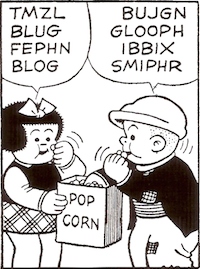"But remember, in a normal case of teletransportation . . ."
The context: a conversation about the work of philosopher Derek Parfit.
[Used with permission. Thanks, Ben!]
Related reading
All "domestic comedy" posts
Friday, March 27, 2009
Domestic comedy
By
Michael Leddy
at
10:15 AM
comments: 0
![]()
Thursday, March 26, 2009
Stimulus package
Just 3.5 oz: chocolate-covered coffee beans. They help to promote class discussion.
By
Michael Leddy
at
8:11 PM
comments: 1
![]()
"Professionally-ran"
From a commercial: "–––– is a professionally-ran radio station."
[T., this one's for you.]
By
Michael Leddy
at
3:39 PM
comments: 2
![]()
Wednesday, March 25, 2009
Pencil crossword
"Get The Lead Out!" is a pencil-themed crossword by Barrel of a Pencil. It's Sunday-sized, with many clever clues and great pencil-related answers, some quite unexpected. This puzzle is available as a PDF from Pencil Talk.
Thanks, Barrel of a Pencil. Thanks, Pencil Talk.
By
Michael Leddy
at
8:11 PM
comments: 4
![]()
Good advice from Harvey Pekar
"If you don't correct stuff right when it happens, you can get into serious trouble. Stay on it."In this story, illustrated by Ty Templeton, Pekar schedules physical therapy for a mending elbow, has a false tooth reglued, and gets a missing screw for his glasses replaced. "Keep on pushin'," he thinks, as the story closes. "Keep on pushin'."
Harvey Pekar, "You Get Old You Can Fall Apart (We're a Winner)," in American Splendor: Another Dollar (New York: DC Comics, 2009), 45.
Other Harvey Pekar posts
A few words from Harvey Pekar
Harvey Pekar on life and death
Harvey Pekar's The Quitter
Review: Leave Me Alone!
By
Michael Leddy
at
7:52 PM
comments: 2
![]()
Tuesday, March 24, 2009
After William Carlos Williams
This Is Just to SayPart of what makes William Carlos Williams' 1934 poem "This Is Just to Say" a great poem is its refusal to offer anything as self-serving as a confession of guilt and sorrow for eating forbidden — or "probably" forbidden — fruit. The poem's mock-melodrama — "Forgive me" — is followed by a reminder of how wonderful the plums tasted: "they were delicious / so sweet / and so cold." Not "they looked delicious": there's no justification of transgression in these lines. Williams' poem suggests a playful, knowing relationship between two people, each with a capacity for humor, tolerance, and, yes, forgiveness. To say nothing after eating these plums would be to engage in passive-aggressive theft. To say more, proclaiming guilt and resolving to never, ever do it again, would be to put up a false rhetorical front. Hence, what the poem says is just to say, right, fitting, appropriate to the occasion.
after William Carlos Williams
I am actually
grateful
for this first
opportunity
to publicly
speak
about
my crimes
for which
I am so
deeply sorry
and ashamed
Bernard Madoff (2009)
How false, in contrast, Bernard Madoff's words look: actually, opportunity, publicly, deeply. Feeling grateful for an "opportunity" — had anyone denied it? — to speak of what makes one deeply ashamed: that must be a difficult trick to master.
By
Michael Leddy
at
11:54 AM
comments: 4
![]()
Monday, March 23, 2009
Mongol No. 2 3/8
To associate the pencil with "the Orient," at one time the source of the finest graphite. Eberhard Faber introduced the Mongol in 1900.
Why graphite?
"Lead" = graphite and clay.
There's no lead in pencil lead?
No, there's no lead in pencil lead. Or yes, there's no lead in pencil lead. Whichever answer is correct. I've never figured out how that works.
Why yellow?
See the response to the first question.
Why a star in a diamond?
An icon of excellence, I guess. On August 22, 1960, the New York Times reported that Eberhard Faber was introducing "Diamond Star" lead for the Mongol, lead that purported to be virtually unbreakable in normal use. (Imagine: a world in which pencil lead was newsworthy.) But the Diamond Star was already appearing on Mongols in the 1950s. (I just looked at an old ad to check.) Pencils with the new lead were marked with a dot. I don't know how long Diamond Star lead was in production.
Is woodclinched a word?
Not according to the Oxford English Dictionary. But the verb clinch has to do with making things firm and sure. So the word has something to do with the process of joining lead and wood. The Eagle Pencil Company proclaimed its pencils "Chemi-Sealed," another name for the same sort of process.
[Yawn.] Can we go back to the ad?
It's on a wall in the room that we call "the study." The ad shows a hand holding a pencil, with a penny nearby. The ad says
Your Best Buy'sCool. I think I've read those words online before.
MONGOL
2,162 words
for
one cent
Here, perhaps?
Yes, I believe so. So how old is this pencil?
Beats me. My dad gave it to me, knowing how much I like pencils. I would guess that it's likely to be from the 1960s or '70s. But the eraser is still good — perhaps because the pencil was kept away in a drawer. Or maybe it's a special Diamond Star eraser. At any rate, the pencil predates Mongols as I know them from the 1980s and '90s.
And why 2 3/8?
I was afraid you'd ask. I don't know. Henry Petroski notes that trademark battles led to pencil gradations of 2 1/2, 2 4/8, 2 5/10, and 2.5. My guess is that with a fairly limited number of ways to sell a product, this unusual designation gave the Mongol some extra bit of distinction.
John Steinbeck for one was impressed by the No. 2 3/8 Mongol. From a letter that he wrote while working on East of Eden:
This is the day when I am stabbing the paper. So today I need a harder pencil at least for a while. I am using some that are numbered 2 3/8.Elsewhere in a letter Steinbeck notes that the No. 2 3/8 Mongol "holds its point well" and that he plans to get "six more or maybe four more dozens of them for my pencil tray." Four more dozens!
*
January 2, 2015: Sean at Contrapuntalism dates the diamond star emblem to 1903–1904.
January 5, 2015: A 1946 United States patent application describes the diamond star as being “continuously used and applied” to Eberhard Faber goods “since about 1909.” Thanks again to Sean at Contrapuntalism.
June 8, 2015: Sean at Contrapuntalism spoke with Eberhard Faber IV, who says that the Mongol was named for John Eberhard’s favorite soup: purée Mongole. I’ve left the above explanation as is: I think that an association with "the Orient" is what what the buying public would have seen in the name Mongol .
June 22, 2016: Sean at Contrapuntalism reports that the Eberhard Faber Company applied for a diamond star trademark in 1905.
[The 1900 date for the Mongol comes from Larry R. Pack's Made in the Twentieth Century: A Guide to Contemporary Collectibles (Lanham, Maryland: Scarecrow Press, 2005). Henry Petroski's The Pencil: A History of Design and Circumstance (New York: Alfred A. Knopf, 1990) is my source for the significance of the name Mongol and the color yellow and for a reference to the 1960 Times article, which I read in the Times archive. The dating of the star in the diamond is from my observation. Petroski's book is also the source for the information about trademark battles and for the first Steinbeck quotation, which led me to Steinbeck's Journal of a Novel: The East of Eden Letters (New York: Viking Press, 1969) and the other quotations. The Pencil is a great book for anyone interested in culture, design, technology, and writing.
This post is the third in an occasional series, "From the Museum of Supplies." The museum is imaginary. The supplies are real. Supplies is my word, and has become my family's word, for all manner of stationery items.]
Also from the Museum of Supplies
Rite-Rite Long Leads
Real Thin Leads

By
Michael Leddy
at
6:52 AM
comments: 6
![]()
Friday, March 20, 2009
The Brooklyn National Anthem
Spring has sprung, the grass has riz.My mom has recited these words, perhaps without knowing their borough-wide significance. Ladies and gentlemen, please rise for the Brooklyn National Anthem.
I wonder where the birdies is.
By
Michael Leddy
at
3:18 PM
comments: 2
![]()
Spinal Tap and the BBC
The volume sliders for BBC video clips go up to eleven. See and hear for yourself, as Prince Charles busts a move, or several of them:
Prince Charles' Amazon dance (BBC News)
By
Michael Leddy
at
8:41 AM
comments: 0
![]()



